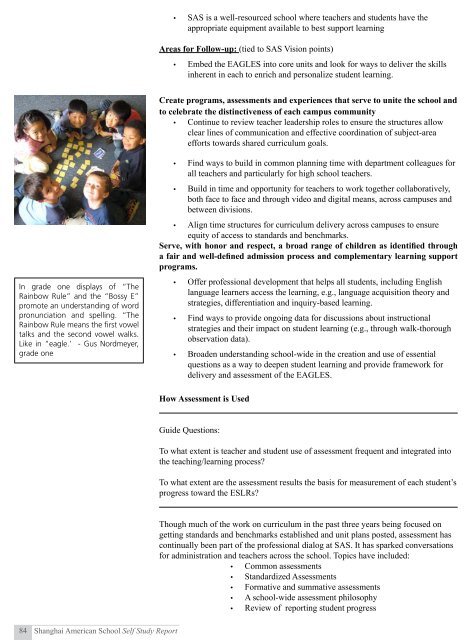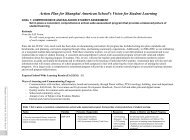•<strong>SAS</strong> is a well-resourced school where teachers <strong>and</strong> students have theappropriate equipment available to best support learningAreas for Follow-up: (tied to <strong>SAS</strong> Vision points)• Embed the EAGLES into core units <strong>and</strong> look for ways to deliver the skillsinherent in each to enrich <strong>and</strong> personalize student learning.Create programs, assessments <strong>and</strong> experiences that serve to unite the school <strong>and</strong>to celebrate the distinctiveness of each campus community• Continue to review teacher leadership roles to ensure the structures allowclear lines of communication <strong>and</strong> effective coordination of subject-areaefforts towards shared curriculum goals.In grade one displays of “TheRainbow Rule” <strong>and</strong> the “Bossy E”promote an underst<strong>and</strong>ing of wordpronunciation <strong>and</strong> spelling. “TheRainbow Rule means the first voweltalks <strong>and</strong> the second vowel walks.Like in “eagle.’ - Gus Nordmeyer,grade one• Find ways to build in common planning time with department colleagues forall teachers <strong>and</strong> particularly for high school teachers.• Build in time <strong>and</strong> opportunity for teachers to work together collaboratively,both face to face <strong>and</strong> through video <strong>and</strong> digital means, across campuses <strong>and</strong>between divisions.• Align time structures for curriculum delivery across campuses to ensureequity of access to st<strong>and</strong>ards <strong>and</strong> benchmarks.Serve, with honor <strong>and</strong> respect, a broad range of children as identified througha fair <strong>and</strong> well-defined admission process <strong>and</strong> complementary learning supportprograms.• Offer professional development that helps all students, including Englishlanguage learners access the learning, e.g., language acquisition theory <strong>and</strong>strategies, differentiation <strong>and</strong> inquiry-based learning.• Find ways to provide ongoing data for discussions about instructionalstrategies <strong>and</strong> their impact on student learning (e.g., through walk-thoroughobservation data).• Broaden underst<strong>and</strong>ing school-wide in the creation <strong>and</strong> use of essentialquestions as a way to deepen student learning <strong>and</strong> provide framework fordelivery <strong>and</strong> assessment of the EAGLES.How Assessment is UsedGuide Questions:To what extent is teacher <strong>and</strong> student use of assessment frequent <strong>and</strong> integrated intothe teaching/learning process?To what extent are the assessment results the basis for measurement of each student’sprogress toward the ESLRs?Though much of the work on curriculum in the past three years being focused ongetting st<strong>and</strong>ards <strong>and</strong> benchmarks established <strong>and</strong> unit plans posted, assessment hascontinually been part of the professional dialog at <strong>SAS</strong>. It has sparked conversationsfor administration <strong>and</strong> teachers across the school. Topics have included:• Common assessments• St<strong>and</strong>ardized Assessments• Formative <strong>and</strong> summative assessments• A school-wide assessment philosophy• Review of reporting student progress84Shanghai American School Self Study Report
These discussions have, in part, arisen from the One School Two Campuses visionthat requires common curriculum – <strong>and</strong> therefore, common assessments. In thepast two years, much discussion has happened around how we define commonassessment. Program review task forces are identifying parameters of commonassessment for their subject areas <strong>and</strong> determining frequency <strong>and</strong> curriculum str<strong>and</strong>sto be assessed. Many subject areas now have common assessments through gradeten – some subjects are using portfolios for that purpose, others use examinations ororal presentations. Most subject areas with common assessments in place are using avariety of assessment types to commonly assess student learning. Continued attentionis needed to ensure that all subject areas develop common assessments, that commonassessments in place be refined, <strong>and</strong> that time for moderation of those assessments beallotted across campuses.St<strong>and</strong>ardized AssessmentsIn addition to common assessments, <strong>SAS</strong> uses st<strong>and</strong>ardized assessment tools likethe Iowa Test of Basic Skills (ITBS), the ERB writing test, Developmental ReadingAssessment (DRA), DIBELS, International Baccalaureate exams (IB) <strong>and</strong> AdvancedPlacement exams (AP), Rigby <strong>and</strong> WAP-T.Through IB <strong>and</strong> AP preparation <strong>and</strong> external examinations, most grade eleven <strong>and</strong>twelve courses also have common rubrics <strong>and</strong> assessments. The exceptions are thosecourses that are neither IB nor AP courses or are singleton courses. At present, thereare no external assessments to measure student progress in grades nine <strong>and</strong> ten.The midterm recommendations call for focus on disaggregating assessment data.This is an area the school is beginning to address through curriculum review taskforces. In addition, some teachers report using external data to inform instruction(see Subject Area Evidence Binders), but the practice is more prevalent in some gradelevels <strong>and</strong> some subject areas than in others. One area for attention is consistentdisaggregation of data across the school to inform teaching. The school is in the veryearly stages of this work; there is much to do.In addition, the school needs to review the external assessments it uses to determineif they are the best match for our students, e.g., ITBS or other instruments. It isimportant, not necessarily to access all data, but to gather that which has the mostimpact student learning. Included in this work is a review the external assessmentdata gathered in grade nine <strong>and</strong> ten to determine what data to gather to enhancelearning without further raising stress levels in an already academically highpressuredenvironment.Lin Chang in grade 11, talks to MsManassa, during her IB art critique.“I think it is actually much more fun(to explain <strong>and</strong> reflect upon my art)than to slave over the painting.”She says that reflection helps herplan her future work. Ms Manassa,a high school science teacher,encourages Lin to describe herprocess.Formative AssessmentIn some subject areas <strong>and</strong> grade levels, kindergarten <strong>and</strong> music, for example,formative assessments are integrated into the teaching <strong>and</strong> learning process, withstudent participation through the use of frequent formative feedback. In somedepartments <strong>and</strong> subject areas, however, formative assessment is not in generalpractice. There is need for professional development on formative assessment forthese groups.Assessing the EAGLESIn the fall of 2007 the SEARCH Assets survey was aligned to the <strong>SAS</strong> EAGLES inan effort to find a way to quantitatively measure our progress. The most recent surveyresults, which arrived in August 2007, were used as a baseline for measuring ourprogress toward achieving the EAGLES. A committee of teachers <strong>and</strong> administratorsanalyzed the results, which, in summary, identified EAGLES areas of strength toinclude:• Adaptable self motivated learners• Skilled inquirers who strive for academic excellenceThe Survey indicated EAGLES areas for follow-up include:Shanghai American School Self Study Report 85



